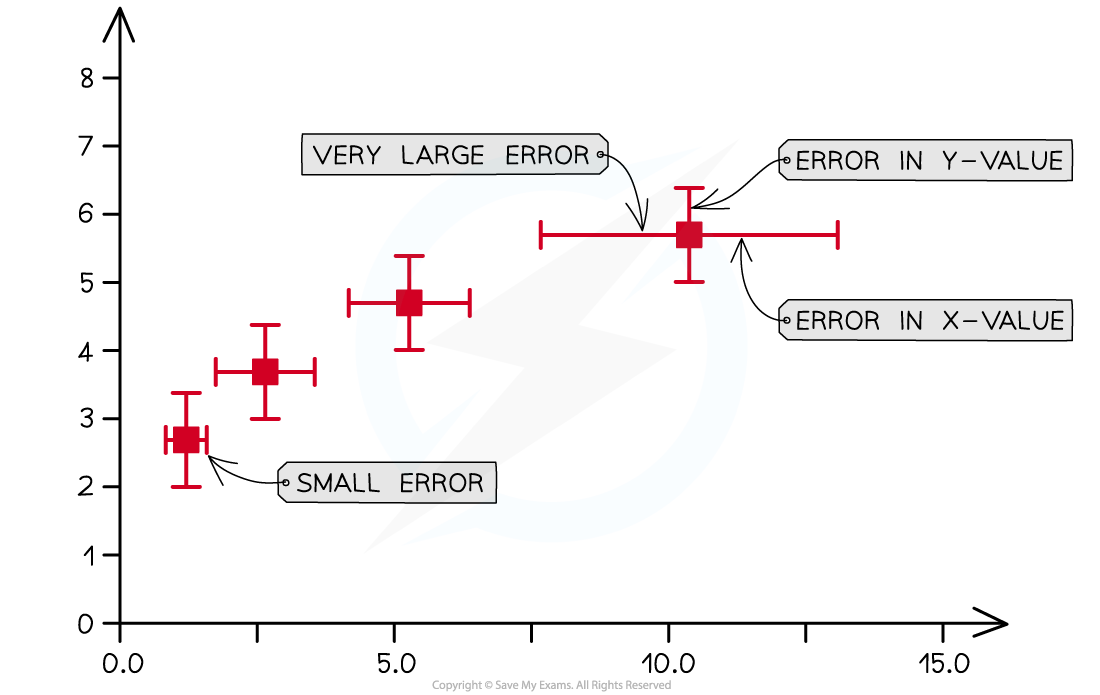Determining Uncertainties from Graphs (DP IB Physics) : Revision Note
Determining Uncertainties from Graphs
The uncertainty in a measurement can be shown on a graph as an error bar
This bar is drawn above and below the point (or from side to side) and shows the uncertainty in that measurement
Error bars are plotted on graphs to show the absolute uncertainty of values plotted

Representing error bars on a graph
To calculate the uncertainty in a gradient, two lines of best fit should be drawn on the graph:
The ‘best’ line of best fit, which passes as close to the points as possible
The ‘worst’ line of best fit, either the steepest possible or the shallowest possible line which fits within all the error bars

The line of best fit passes as close as possible to all the points. The steepest and shallowest lines are known as the worst fit
The percentage uncertainty in the gradient can be found using the magnitude of the 'best' and 'worst' gradients:
percentage uncertainty =
Either the steepest or shallowest line of best fit may have the 'worst' gradient on a case-by-case basis.
The 'worst' gradient will be the one with the greatest difference in magnitude from the 'best' line of best fit.
The equation above is for the case where the 'worst' gradient is the shallowest.
If the 'worst' gradient is the steepest, then the 'worst' gradient should be subtracted from the 'best' gradient and then divided by the best gradient and multiplied by 100
Alternatively, the average of the two maximum and minimum lines can be used to calculate the percentage uncertainty:
percentage uncertainty =
The percentage uncertainty in the y-intercept can be found using:
percentage uncertainty =
percentage uncertainty =
Percentage Difference
The percentage difference gives an indication of how close the experimental value achieved from an experiment is to the accepted value
It is not a percentage uncertainty
The percentage difference is defined by the equation:
percentage difference =
The experimental value is sometimes referred to as the 'measured' value
The accepted value is sometimes referred to as the 'true' value
This may be labelled on a component such as the capacitance of a capacitor or the resistance of a resistor
Or, from a reputable source such as a peer-reviewed data booklet
For example, the acceleration due to gravity g is known to be 9.81 m s–2. This is its accepted value
From an experiment, the value of g may be found to be 10.35 m s–2
Its percentage difference would therefore be 5.5 %
The smaller the percentage difference, the more accurate the results of the experiment
Worked Example
On the axes provided, plot the graph for the following data and draw error bars and lines of best and worst fit.

Find the percentage uncertainty in the gradient from your graph.

Answer:
Step 1: Draw sensible scales on the axes and plot the data

Step 2: Draw the errors bars for each point

Step 3: Draw the line of best fit

Step 4: Draw the line of worst fit

Step 5: Work out the gradient of each line and calculate the percentage uncertainty

best gradient =
worst gradient =
% uncertainty =
Examiner Tips and Tricks
A common misconception is that error bars need to all be the same size. In physics, this is not the case and each data point can have different error bar sizes as they have different uncertainties.

You've read 0 of your 5 free revision notes this week
Sign up now. It’s free!
Did this page help you?
